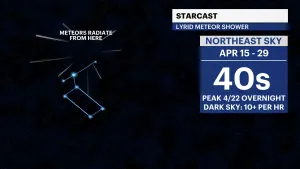More Stories
Some parts of the northern U.S. may be able to see the Northern Lights this weekend, but will we actually be able to see them here this time?
Well, it will be a stretch, but never say never.

The Space Weather Prediction Center continues with its G3 Watch, or strong geomagnetic storm watch, through the weekend due to a series of coronal mass ejections (CME’s) heading right toward Earth. Sunspot AR3842 continues to be very active, and it’s produced some very strong solar flares since Tuesday.
They were X-class flares, and these measured as the strongest so far in solar cycle 25 that we are currently in.

The flares don’t actually create the geomagnetic storms on Earth, but most times with strong flares, CME’s (or clouds of the sun’s particles) follow. This time they did. It takes a couple of days for them to arrive here on Earth. This is the reason for the watch – it means a geomagnetic storm is possible and also possible that the aurora will develop too.
We usually need a stronger storm to produce vivid and bright enough aurora to be seen in the light-polluted skies of the tri-state area.
With a G3 storm, there will be a Kp index of 7. That is usually strong enough to see the aurora at around 50 degrees latitude and that’s just a little too far north of us.
With the recent past geomagnetic storms, some in our area have taken beautiful photos using long exposure to capture some of the gorgeous colors dancing in the northern sky.

They were usually in dark, remote northern areas and also seen with long exposure photography.
The best areas to view will be remote, rural and higher in elevation.
Unfortunately, it’s not just the light pollution in the way, but clouds and even some rain for Sunday night.
Be sure to check back for more on the space weather forecast and your own local forecast on News 12.
More from News 12
2:13

Saturn in opposition this weekend. Find the best time to view the ringed planet
2:09

Nutrition takes backseat in cereals marketed toward children, study finds
2:00

Geminids Meteor Shower to peak Friday & Saturday
1:13

Aphelion Day: The Earth is now at its farthest distance away from the sun
1:45

Planetary Parade! A number of planets will be visible in the sky this weekend
1:48
